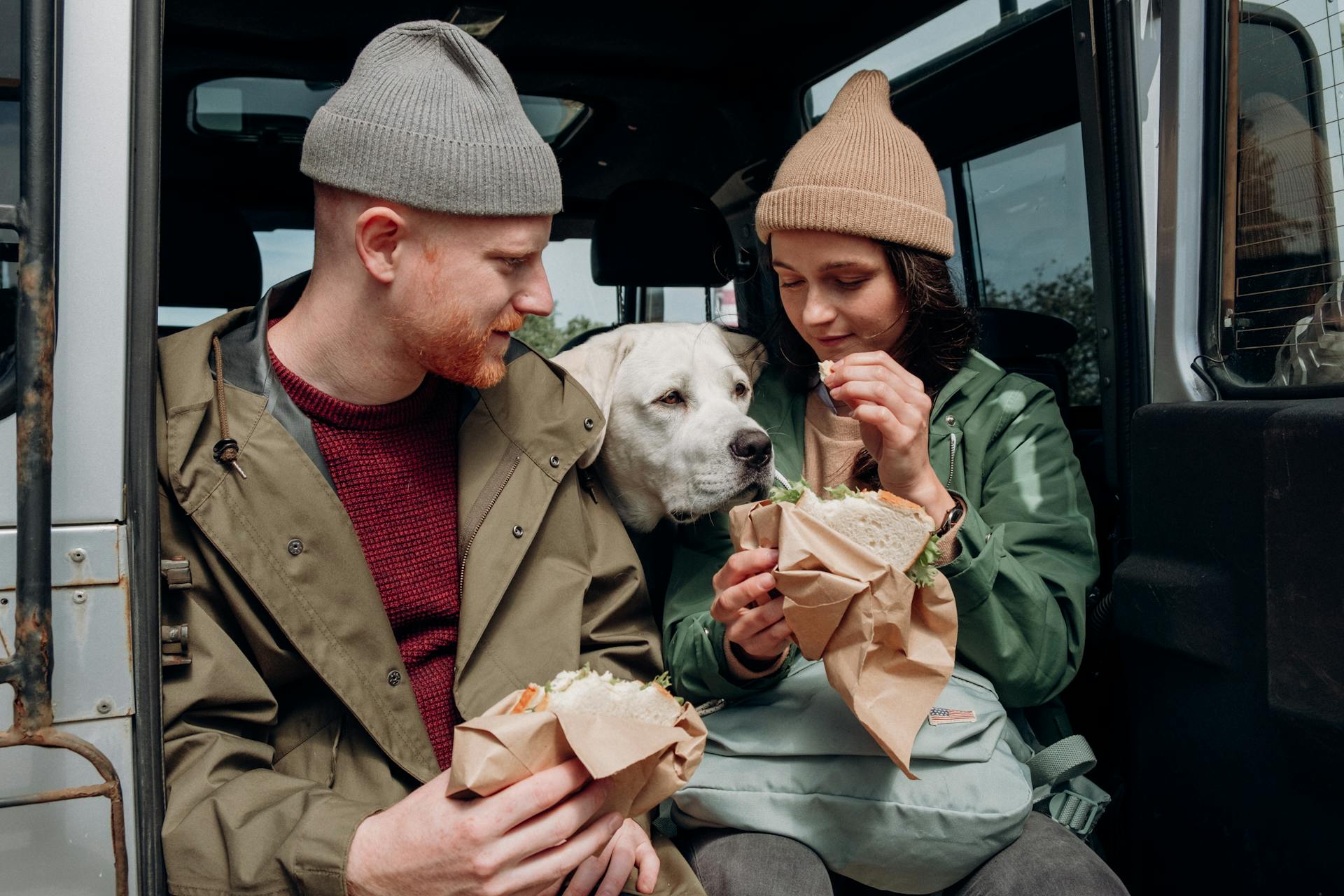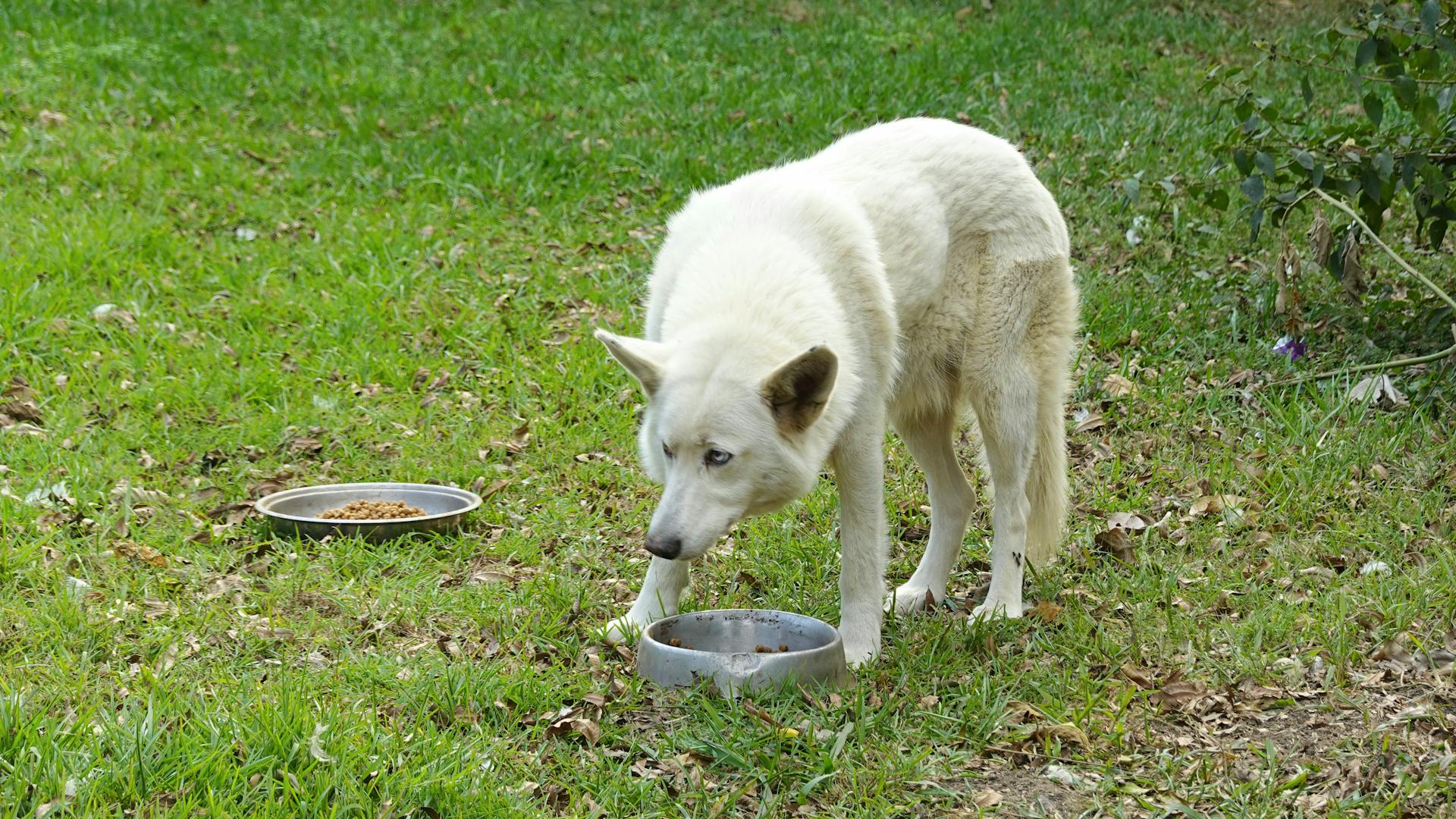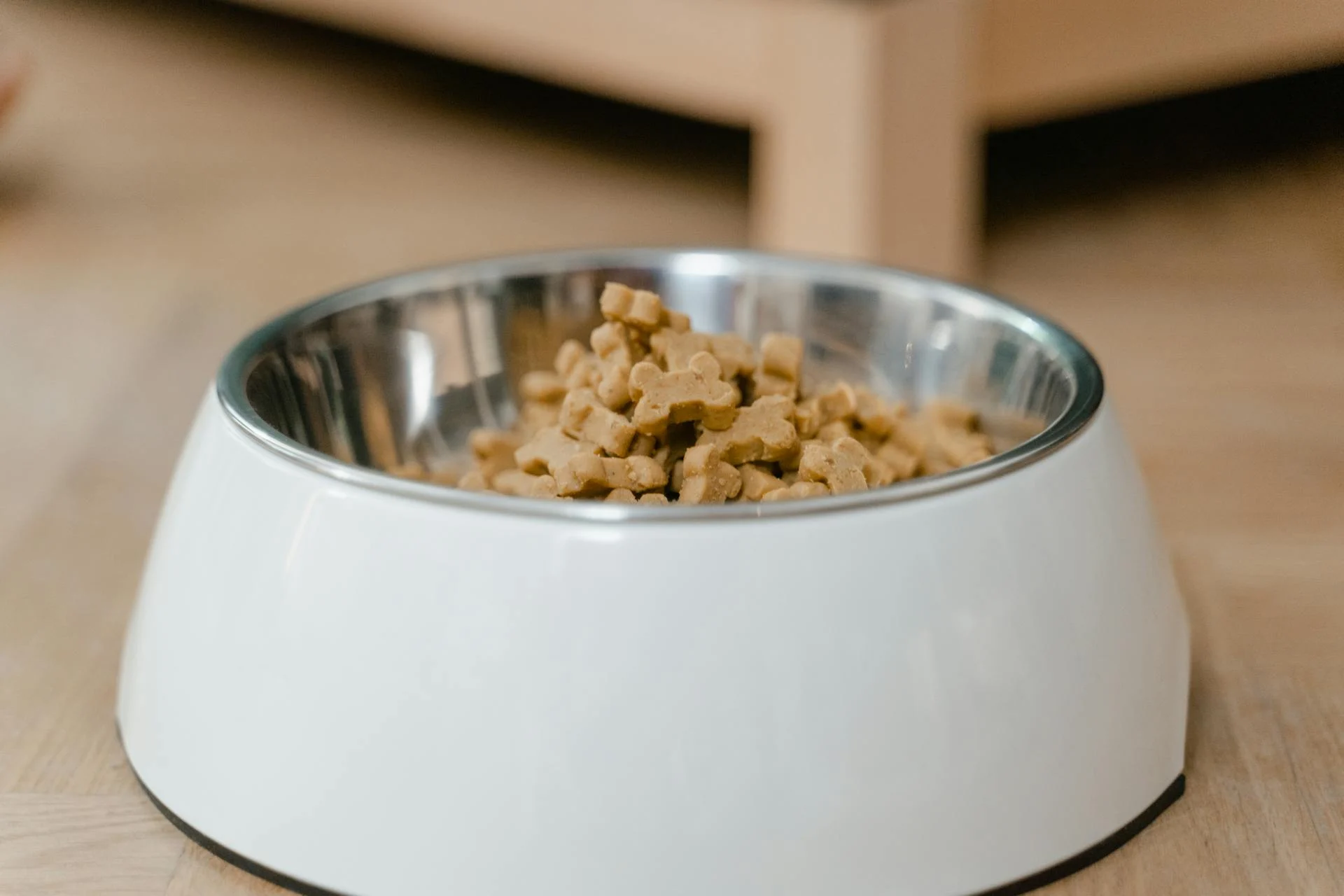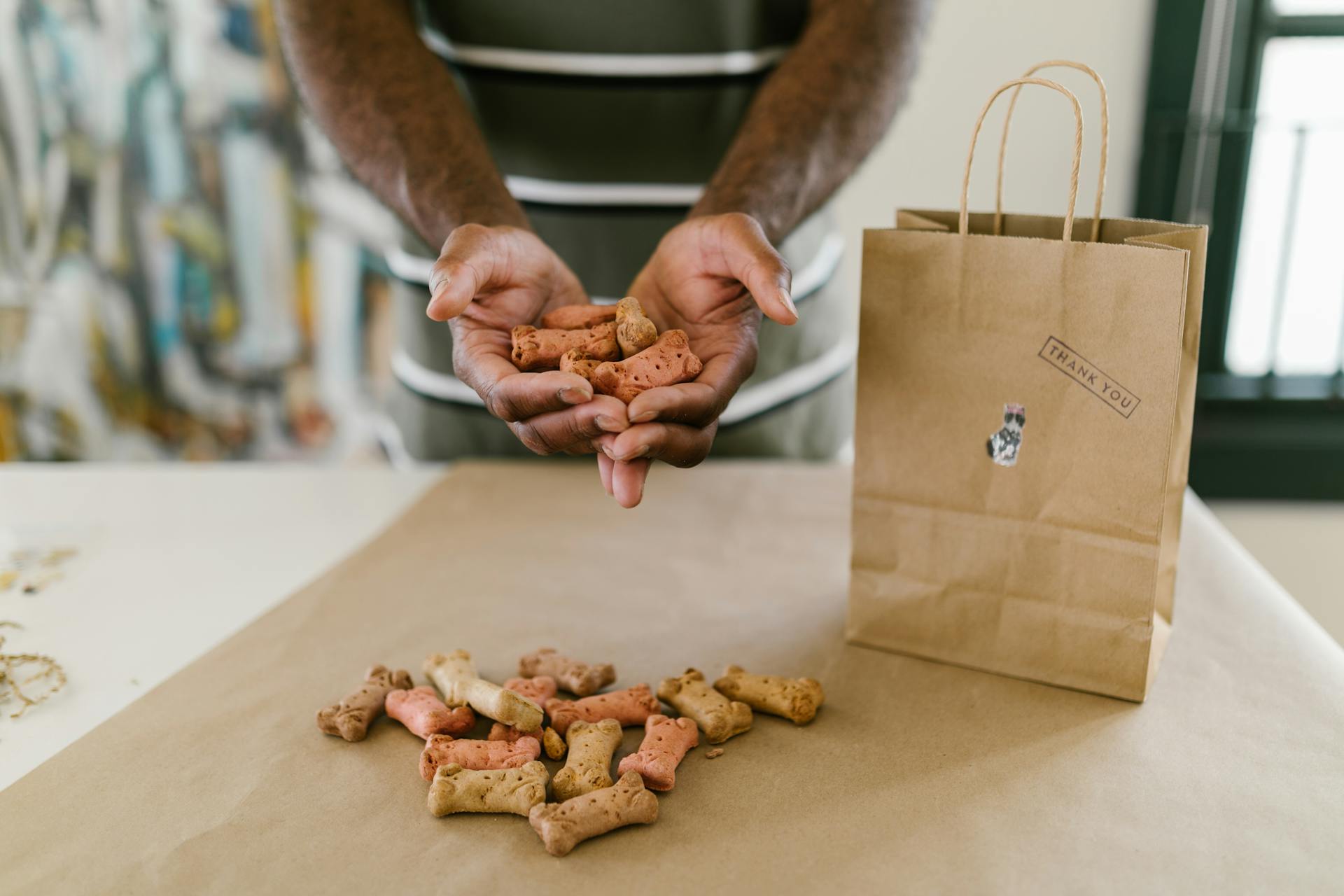
A dog food trial is a great way to identify potential food allergies or sensitivities in your furry friend. This trial typically lasts 6-8 weeks and involves feeding a single protein source, such as venison or salmon, for the entire duration.
The goal is to isolate the protein source and see if your dog's symptoms improve or worsen. A good starting point is to choose a novel protein source that your dog has never had before.
During the trial, it's essential to monitor your dog's stool quality, skin health, and overall energy levels. Keep a detailed log of any changes you notice, as this will help you track progress and make informed decisions.
If your dog experiences an improvement in symptoms, it may indicate a food allergy or sensitivity.
You might like: Is High Protein Dog Food Good for Dogs
Understanding Canine Allergies
A food trial for your dog can be a lengthy process, typically lasting 8-12 weeks.
The goal of this trial is to identify the specific ingredient causing your dog's allergy symptoms. Your veterinarian will guide you through a hypoallergenic diet trial.
A food challenge is a crucial step in the trial process, where specific ingredients are added back into your dog's diet. Most dogs will react to the offending allergen within 24-48 hours.
It's not uncommon for dogs to have multiple food allergens, but in most cases, there is only one ingredient causing the issue.
The elimination diet is a key part of the trial, where your dog is fed a special diet that doesn't contain the possible offending proteins. If symptoms improve, it's a good sign that the diet is working.
A food challenge involves reintroducing food and treats that your dog was previously eating. If symptoms flare up, it's a clear indication that the ingredient is causing a reaction.
Confirmation is the next phase, where your dog is put back on a strict elimination diet. If symptoms resolve, it confirms an adverse food reaction diagnosis.
Identifying the specific ingredient causing the allergy can take some time, but it's essential to avoid the offending allergen. This involves continuing the elimination diet and gradually introducing small amounts of previously fed ingredients.
A different take: Pros and Cons of Raw Food Diet for Dogs
Elimination Diet Process
The elimination diet process can be a game-changer for dogs with food allergies. This involves switching your dog to a relatively hypoallergenic diet to see if their symptoms improve.
The new diet should be followed for a few weeks to allow your dog's body to adjust and start responding positively. Traditional novel protein diets typically take 8-12 weeks to see significant improvement, while newer hydrolyzed diets may show results in as little as 6 weeks.
Recommended read: Why Do Dogs Drool When They See Food
Veterinary Elimination Diet
The veterinary elimination diet is a systematic approach to identifying the food culprit behind your dog's symptoms. This process involves a relatively hypoallergenic diet that allows your dog's symptoms to improve.
You'll know it's time for the reintroduction challenge when your dog's symptoms start to improve on the new diet. This is a crucial step in identifying the specific food allergen causing the issues.
The reintroduction challenge involves systematically reintroducing individual ingredients from the previous diet, while monitoring for a return of clinical signs. This helps pinpoint the exact food allergen causing the problems.
Traditional novel protein diets typically take 8-12 weeks to complete, at the discretion of the veterinary dermatologist.
Here's an interesting read: Food Diet for Dogs
Eating Accidentally Ingested Food

Eating accidentally ingested food can be a major setback in the elimination diet process. The food trial starts over, even occasional transgressions can seriously hinder our ability to make the diagnosis of a food allergy.
Make sure all family members and visitors to your home know that your pet is eating a prescription diet to avoid any accidental ingestion of other food. This is crucial to ensure the accuracy of the results.
If your pet accidentally eats another pet's food or table scraps, the food trial starts over. This can be frustrating, but it's essential to maintain the integrity of the process.
If this caught your attention, see: How to Stop Dog from Eating Other Dogs Food
Choosing the Right Diet
You'll want to start by considering a novel diet, which uses protein sources like rabbit, kangaroo, or venison that your dog hasn't eaten before.
Novel diets are great for pets with food sensitivities, and they often include carbohydrate ingredients like white potato or sweet potato.
If your dog has a severe food allergy, a hydrolyzed diet might be a better option, as it breaks down protein into tiny pieces that can't trigger an immune response.
Hydrolyzed proteins commonly used in pet foods include chicken, soy, or feather protein.
For a homemade diet, it's essential to consult with a vet or pet nutritionist to ensure it's balanced and complete.
Remember, commercial diets labeled "hypoallergenic" or "for sensitive skin" aren't officially validated, so take those claims with a grain of salt.
Types of Diets
Choosing the right diet for your furry friend can be overwhelming, but let's break it down.
There are several types of diets to consider, each with its own benefits and drawbacks.
A Novel Diet is a great option, featuring protein sources like rabbit, kangaroo, venison, pork, or fish, and carbohydrate ingredients like white potato or sweet potato.
These ingredients are new to your pet, making it easier to identify potential allergens.
Hydrolyzed Diets, on the other hand, contain proteins broken down into tiny fragments that the immune system shouldn't recognize.
This makes them a good choice for pets with severe skin infections or recurring flareups.

If you're considering a homemade diet, be sure to consult your vet or a pet nutritionist for the right formulation – it needs to be balanced and complete.
Commercial diets labeled as "hypoallergenic" or "for sensitive skin" can be misleading, so it's best to take these claims with a grain of salt.
Here are the three main types of diets:
Wet Good for Dogs?
Wet food can be a nutritious choice for dogs, as it's made with a higher moisture content than dry food, which can help keep them hydrated.
The ingredients in wet dog food can be beneficial for dogs, including those with sensitive stomachs or allergies.
Wet food typically contains more protein and fewer fillers than dry food, making it a popular choice for many dog owners.
Some wet dog foods are made with named protein sources, such as chicken or salmon, which can be a plus for dogs who thrive on a specific type of protein.
Here's an interesting read: Is Pedigree Dry Dog Food Killing Dogs
However, not all wet dog foods are created equal, and some may contain low-quality ingredients or preservatives that can be detrimental to a dog's health.
Dogs with certain health conditions, such as kidney disease, may benefit from a wet food diet due to its lower phosphorus content.
It's essential to choose a high-quality wet dog food that meets your dog's individual needs and health status.
For another approach, see: Mixing Dry Food and Wet Food for Dogs
Managing the Diet
Traditional novel protein diets take 8-12 weeks at the discretion of the veterinary dermatologist.
You'll need to work closely with your vet to determine the right duration for your dog's diet trial. This will help ensure your dog gets the best results.
Newer, hydrolyzed diets may only take up to 6 weeks to see improvement.
Keep in mind that every dog is different, and some may take longer to adjust to their new diet.
Expert Insights and Tips
A dog food trial can be a bit of a pain, but it's a crucial step in figuring out what's causing your dog's food allergies. Dr. Laura Wilson explains that it's essential to get a strict diet history from your dog's previous food to start the trial.
The goal of a diet trial is to have your dog eat a novel protein and carbohydrate, with limited preservatives and fillers, for a period of six to eight weeks. This means cutting out all other foods, including commercial treats, vitamin supplements, snacks, and even table scraps.
To make the trial successful, it's essential to keep your dog strictly confined indoors or monitor them closely when outside to prevent hunting or scavenging. You should also ensure that there's enough trial food to last the entire eight weeks, and avoid breaks during the trial period.
Explained by an Expert
Dog food trials can be a crucial step in figuring out if your dog has a food ingredient allergy. Dr. Laura Wilson, a veterinarian, explains that these trials are not as simple as just switching to a new food, but rather a carefully planned process.
A dog food trial involves getting a strict diet history from the owner to identify any potential allergens. This includes not just prescribed medications, but also any supplements or vitamins being given to the dog.
Recommended read: Sheepdog Trials 2023

The goal of a dog food trial is to feed a novel protein and carbohydrate, with limited preservatives and fillers, for a period of 6 to 8 weeks. This allows the dog to have a consistent diet that can help identify any food sensitivities.
However, Dr. Wilson notes that home-prepared diets can be unbalanced, especially for young dogs or those with underlying medical issues. In these cases, a traditional diet trial may not be possible.
A successful dog food trial requires careful planning and follow-up. Dr. Wilson recommends a visit or phone call before re-challenging the dog with their original diet.
Tips for Success
Keep your pet's environment clean and free from distractions to ensure a successful food trial. This means no sneaking into the kitchen to snag table scraps or getting into the other pets' food.
Make sure to consult with your vet before offering any healthy treats, such as carrot slices or apples, to your pet during the trial. They can help you determine what's safe and what's not.

Avoid disguising oral medications in foods like cheese or sausage, as this can make it difficult to track your pet's reaction to the new diet. Instead, try making meatballs from their canned food or using sweet potatoes to mask the medication.
Feed your pets separately to prevent food stealing and make sure any bag of pet food is kept out of your pet's reach.
Frequently Asked Questions
Does Purina do feeding trials?
Yes, Purina conducts feeding trials on all their puppy foods. This rigorous testing helps ensure the nutritional quality and safety of their products.
Sources
- https://www.dvm360.com/view/identifying-food-allergies-veterinary-elimination-diet-trial
- https://chappellevet.ca/diagnosing-food-allergies-in-dogs-elimination-diet-trials/
- https://www.justfoodfordogs.com/blog/dog-food-trial.html
- https://firstvet.com/us/articles/how-to-perform-a-food-trial-for-your-pets-allergies
- https://dermvets.com/help-pets-itchy-skin/pet-food-allergy-dermatitis/dietary-elimination-trial/
Featured Images: pexels.com


